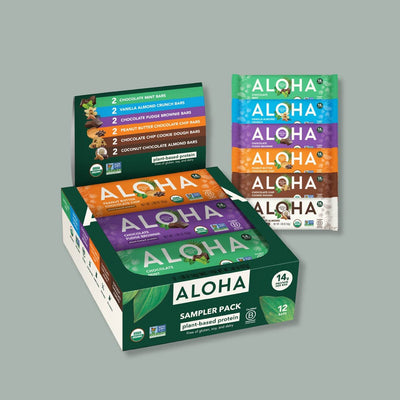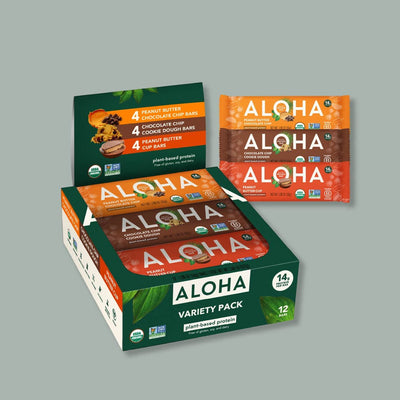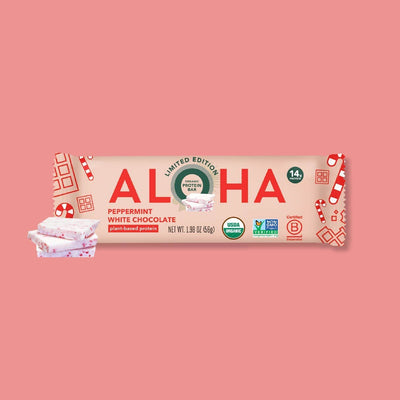Key Takeaways:
- Protein Doesn’t Have to Be Complicated: Adding more protein can be as easy as snacking smarter or making small tweaks to your meals. You don’t need strict plans to make a difference.
- Plant-Based Works Well: From protein bars to lentils and seeds, there are plenty of clean ways to fuel your day. It all starts with knowing what works for your lifestyle.
- Preparation Makes Protein More Consistent: Keeping snacks on hand and staying aware of your options helps you stick with them. A little planning makes protein part of your daily rhythm.
Are you looking to get more protein into your diet without overthinking every meal or snack? It’s a common goal for anyone trying to feel better, stay energized, and make more intentional food choices—especially when using plant-based or clean ingredients. The challenge isn’t always what to eat but how to make protein feel like a natural part of your day.
We’re ALOHA and believe that good food should be simple, satisfying, and rooted in real ingredients. Our organic, non-GMO, plant-based protein products are made for people who care about what they eat—without needing a degree in nutrition to understand what’s inside. We’ve built a reputation on transparency, taste, and quality that speaks for itself.
In this piece, we’ll walk through how to get more protein with approachable tips, smart swaps, and everyday choices that fit your lifestyle—without the stress.
Why Protein Matters For Your Health
Protein plays a significant role in how your body runs every day. It's involved in nearly every process that keeps you functioning, from your hair and skin to your muscles. It’s not just something for athletes or gym-goers—everyone needs it, especially if you want to maintain energy and support an active lifestyle.
When you're not getting enough, you might feel a bit off—like meals aren’t keeping you satisfied or your focus starts slipping faster than usual. That’s your body nudging you to pay attention. The good news? Boosting your protein intake doesn’t have to be complicated.
Whether you're plant-based, leaning into cleaner eating, or just looking for easy ways to fuel your day, knowing how to get more protein is a simple shift that can have a meaningful impact on your routine.
How Much Protein Do You Really Need?
Understanding your protein needs isn’t about strict numbers—it’s about being more mindful of your body's needs to stay active and nourished. Let’s take a look at a few simple ways to think about daily protein intake without making it complicated:
It Depends On Your Lifestyle
Your body’s protein needs vary depending on age, activity level, and overall wellness goals. Someone who exercises regularly or leads a busy lifestyle may benefit from a slightly higher protein intake than someone with a more sedentary routine.
Small Additions Make A Big Difference
Rather than trying to pack all your protein into one meal, including it throughout your day is often more effective. Spreading protein intake across meals and snacks helps your body use it more efficiently—plus, it makes it easier to meet your goals without effort.
Awareness Over Perfection
You don’t need to count every gram to improve your protein habits. The key is knowing which foods help you and making simple swaps or additions. Once you get the hang of it, learning how to get more protein becomes second nature.
Common Signs You're Not Getting Enough Protein
Sometimes, your body sends subtle signals when something’s missing from your diet. If you're not getting enough protein, you may notice little shifts in how you feel or function. Here are a few signs to be aware of:
- You Feel Hungry Soon After Eating: If your meals aren’t keeping you satisfied for very long, it might be due to a lack of protein. Including a little protein in each meal or snack can help you feel more balanced throughout the day.
- Low Energy Throughout the Day: Feeling tired more often than usual—even with enough sleep—can sometimes be linked to not getting the fuel your body needs. Protein is one of those foundational nutrients that helps support overall energy.
- You Notice Changes in Strength or Focus: Struggling to stay focused or feeling weaker during physical activity may be your body asking for more protein. While it’s not the only factor, it’s easy to adjust and monitor over time.
- Your Hair or Nails Feel Weaker: A lack of certain nutrients, including protein, can sometimes appear in places like your hair and nails. If they’re feeling more brittle or not growing like they used to, it might be worth taking a closer look at your daily protein intake.
- You’re Constantly Craving Snacks: Frequent snacking—especially cravings for quick carbs—might be your body’s way of compensating for a missing building block. Incorporating small protein sources into your meals can help create a better rhythm and reduce those mid-day snack urges.
Easy Ways To Add More Protein To Your Diet
Finding ways to get more protein doesn’t have to mean complicated recipes or constant meal prep. The trick is making small, consistent upgrades that fit your lifestyle. Here are a few practical ideas to make protein a more natural part of your day:
Start With Protein-Packed Snacks
Snack time is a perfect opportunity to sneak in more protein without overthinking it. Reach for things like plant-based protein bars that are easy to grab and made with ingredients you can pronounce. Options like ALOHA’s protein bars, which combine flavor with function, are a simple way to support your daily protein goals. Other great picks include roasted chickpeas, nut butter on whole grain crackers, or even a handful of almonds or walnuts.
Add Protein To Breakfast
Breakfast is your first shot at fueling your day, and it’s often the meal most likely to lack protein. Instead of skipping it or relying only on carbs, add a scoop of protein powder to your morning smoothie or stir it into your oatmeal. You could also keep protein bars or plant-based drinks on hand for mornings when you’re short on time. These small shifts help create a more balanced start without extra effort.
Upgrade Your Regular Meals
You don’t need to reinvent your meals—just make them more protein-friendly. Add lentils to soups, swap white rice for quinoa, toss chickpeas into your salads, or sprinkle hemp seeds on top of your favorite dishes. These ingredients blend well into various cuisines and naturally boost the protein content of foods you enjoy.
Keep Protein Options Within Reach
When juggling work, errands, or travel, having convenient options can make all the difference. Stash a protein bar in your bag, keep a few ready-to-drink protein bottles in the fridge, or have a backup snack in your car. That way, you’re always ready with something quick and nourishing, no matter where your day takes you.
Pre- And Post-Workout Protein Tips
Whether you're heading out for a morning run, squeezing in a strength session, or just staying active in your own way, adding a bit of protein around your workout can help you stay fueled and feel ready to take on the rest of your day. It doesn't need to be complicated—just thoughtful. Here's how to approach it:
Keep It Light Before You Move
Before a workout, it’s best to stick with something light and easy to digest. A small snack with balanced carbs and protein can boost you without weighing you down. A half protein bar, a banana with nut butter, or a few bites of oatmeal blended with plant-based protein powder can give your body gentle support while you move.
Refuel With Something Simple And Satisfying
After a workout, your body appreciates a little replenishment. This doesn’t mean you need a full meal right away—but including a small source of protein can help keep your momentum going. A ready-to-drink plant-based protein shake or a protein bar is a convenient and clean option, especially on the go. Keep it easy, and focus on options that align with your lifestyle and taste preferences.
Consistency Over Perfection
What matters most is finding a routine that works for you. The goal isn’t to hit exact numbers—it’s to make protein a reliable part of your rhythm, especially when your body is working a bit harder. It becomes second nature once you know how to get more protein into these moments.
Final Thoughts
Prioritizing protein is less about strict rules and more about making intentional choices that align with your lifestyle. Whether you aim for sustained energy, better recovery, or simply feeling more balanced throughout the day, finding ways to naturally include protein can make a noticeable difference. It's not about perfection—it’s about creating habits that feel good, support your goals, and make nourishment something you actually look forward to.
Read also:
- Top Benefits Of Vegan Protein Powder
- Why Women Should Include Protein Shakes In Their Routine
- Healthy Work Snacks For Busy Days
Frequently Asked Questions About How To Get More Protein
Can I get enough protein from plants alone?
A balanced plant-based diet can provide plenty of protein through foods like legumes, seeds, nuts, and whole grains. The key is variety—mixing different sources helps you cover your needs. It’s a simple and natural way to support your lifestyle without relying on animal products.
Are there protein-rich foods I can eat if I don't cook much?
Absolutely—plenty of protein-rich options don’t require any cooking at all. Plant-based protein bars, nut butters, hummus, and canned beans are convenient choices. You can build a solid protein habit with just a few pantry staples.
What are some lesser-known plant-based protein sources?
Foods like edamame, tempeh, hemp seeds, and nutritional yeast pack more protein than many expect. They’re great for adding flavor and variety. Incorporating them into salads, bowls, or snacks keeps things interesting and protein-friendly.
Is it better to eat protein before or after a workout?
There’s no single rule—it depends on what works for your body and schedule. A light snack with protein before a workout can help you feel supported, while a small protein boost afterward helps keep you balanced. Consistency over time matters more than timing.
Can I get more protein without eating more calories?
Yes, by focusing on nutrient-dense, protein-rich foods in smaller portions. For example, adding a tablespoon of hemp seeds to your meal gives protein without too many calories. You don’t need to overeat to improve your intake.
How do I stay consistent with protein intake while traveling?
Keeping portable snacks like protein bars or single-serve drinks in your bag helps you stay on track. It’s all about preparing before you go so you’re not stuck without options. ALOHA’s protein products are great for this—they travel well and keep things simple.
Do I need protein at every meal?
Spreading your protein throughout the day makes it easier to meet your needs. You don’t have to get it perfect—just aim to include a source in most meals or snacks. It’s about building a natural rhythm.
Can kids and teens benefit from more protein, too?
Yes, growing bodies need protein just like adults do. Adding protein to meals and snacks is a good habit as long as it’s from clean, age-appropriate sources. Think nut butters, lentils, or small portions of plant-based bars.
Are there protein options that don’t taste like protein?
Absolutely—many modern products are designed with flavor in mind. ALOHA protein bars, for example, focus on real ingredients and crowd-favorite flavors like peanut butter chocolate chip or coconut chocolate almond. You don’t have to settle for chalky textures.
How do I know if a protein product is clean and trustworthy?
Check the label—look for organic certification, non-GMO ingredients, and a recognizable list. Brands like ALOHA are transparent about what goes into their products. If you can pronounce the ingredients, you’re on the right track.
Sources:
1. Poos, M. I., Costello, R., & Carlson-Newberry, S. J. (1999). The Role of Protein and Amino Acids in Sustaining and Enhancing Performance. In www.ncbi.nlm.nih.gov. National Academies Press (US). https://www.ncbi.nlm.nih.gov/books/NBK224683/
2. Antonio, J., Candow, D. G., Forbes, S. C., Ormsbee, M. J., Saracino, P. G., & Roberts, J. (2020). Effects of Dietary Protein on Body Composition in Exercising Individuals. Nutrients, 12(6), 1890. https://doi.org/10.3390/nu12061890
3. Campbell, B., Kreider, R. B., Ziegenfuss, T., La Bounty, P., Roberts, M., Burke, D., Landis, J., Lopez, H., & Antonio, J. (2007). International Society of Sports Nutrition position stand: protein and exercise. Journal of the International Society of Sports Nutrition, 4(1), 8. https://doi.org/10.1186/1550-2783-4-8
ALOHA's products are not intended to treat, diagnose, mitigate, prevent, or cure disease. ALOHA's products should not replace prescribed medications or the variety of foods important to a healthful diet.
Do not self-diagnose any health condition. Work with your healthcare provider to determine how best to achieve optimal health.












